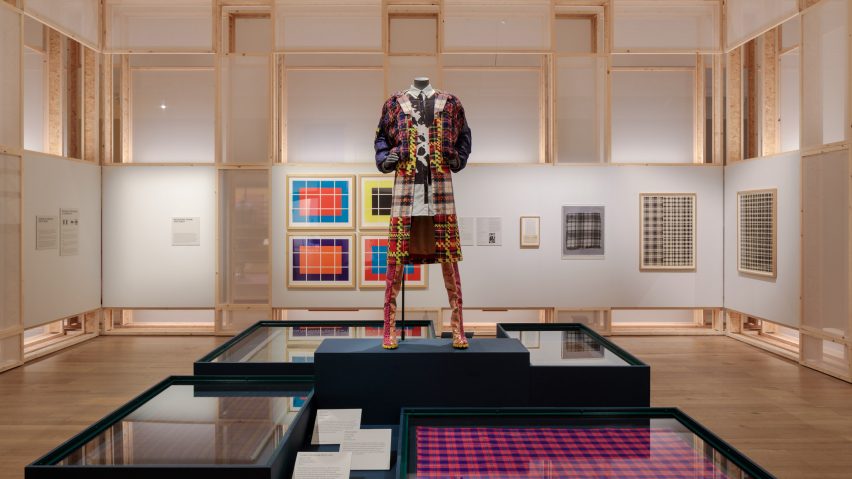Curator Mhairi Maxwell has selected five key items from the V&A Dundee's Tartan exhibition, which aims to "take a radical new look" at the pattern.
Taking place at the V&A Dundee in Scotland, Tartan aims to celebrate the pattern and the many ways it has been used and interpreted.
"Our aim is to take a radical new look at a globally recognised design," explained Maxwell.
"Surprise at every turn was a motivation for us when designing and curating the exhibition," she continued. "Along the way, we also bust some important myths, for example tartan's elusive origins as distinctly Scottish and the so-called ban of tartans post-Culloden."
The exhibition contains over 300 objects that chart the history of the pattern, from the oldest tartan ever discovered and tartan worn by Bonnie Prince Charlie to the high fashion designs of Vivienne Westwood and Alexander McQueen.
However, pieces in the exhibition were arranged thematically rather than chronologically. It is arranged into five sections – The Grid, Tartan and Innovation, Tartan and Identity, Tartan and Power, and Transcendental Tartan.
"We have for the first time, taken a design-led approach to explode tartan's grids," explained Maxwell. "We start by unpicking the rules of the grid and the basic principles of colour, pattern and proportion which make up tartan's instantly recognisable setts [patterns]."
"We look at how these rules of the grid have inspired creativity for designers not only working in textile design and fashion, but also in an incredible range of different design disciplines including architecture, art, film, performance, and even data visualisation, science and technology," she continued. "These rules of the grid are also there to be deconstructed and disrupted, offering unlimited possibilities."
Maxwell hopes that the exhibition will draw attention to tartan's broad range and how the pattern is constantly evolving.
"I think one of the biggest misunderstandings of tartan is that it has stood still, being one of the most documented and regulated textiles in the world," she said.
"The Scottish Register of Tartans now has over 11,000 entries. In fact, it is an endlessly adaptable pattern, and since at least the 16th century it has been reformed and reinvented by diverse communities to express themselves or communicate their cause," she continued.
"Tartan is adored and derided, a source of pride and embarrassment, and is both cool and kitsch. We embrace tartan's conflicted meanings in the exhibition."
Read on for Maxwell's highlights from the exhibition.
Skirt, Belgium, by Jurgi Persoons (2001)
"This skirt's ragged tartan scraps are what the designer calls 'trash couture', where he creates beautiful new designs from selvedge or waste."
"So much of our understanding of tartan and its histories is made up of fragments, from the oldest piece of tartan found in Scotland in a Glen Affric peat bog dating to the 16th century, to the textile relics supposedly cut from Bonnie Prince Charlie's trews."
"Even from the smallest fragment a whole unique tartan pattern can be reconstructed, making it one of the most identifiable textiles in the world."
The Scottish Gael, Edinburgh, by James Loganon (1831)
"In 1831, James Logan's The Scottish Gael was one of the first published catalogues of tartans and was also a strikingly visual attempt to graphically study their patterns, notating thread counts and colourways of hundreds of setts."
"Although his attempt was deemed ultimately flawed when one compared his prints and watercolours to the original samples he was trying to record, with a keen design interest he had nevertheless recognised the rules of the grid and how incredible variation was possible from its limitations. Designers and their clients to this day are free to interpret and reinvent the rules of the grid."
[no title], New York/ Marfa, Texas, by Donald Judd Woodcut (1992 – 1993)
The American artist Donald Judd was fascinated by the symmetrical construction of textiles. These included Turkish rugs which he installed in his New York studio and the tartans which he loved to collect (he was often pictured in a plaid shirt).
He was probably interested in how tartan's repetitive grids, even when fragmented, related to his interest in the vocabulary of forms and their occupation of space. In this series of prints, each framed 'sett' rationalises the tartan grid to building blocks of colour and lines.
Though flat, these prints employ the idea of warp and weft to create the perception of depth. The blocks of colour occupy negative space while the white creates positive space.
Line studies of Tartan, the Netherlands, by Dom Hans van der Laan (1968)
"Dutch architect and Benedictine monk Dom Hans van der Laan was directly inspired by tartan's rules of the grid."
"While only a few of his buildings were realised, including the Abbey at St Benedictusberg, his treatises were influential, and he used the tartan grid as a concept in his teaching as a founding member of the Bossche School of Architecture."
"Pieces of Grey Douglas tartan were found in his archive held at St. Benedictusberg, and he directly studied and applied the proportions he found in these to his architectural theory and practice. He cleverly and imaginatively demonstrated how the proportionate widths of tartan's warp and weft can provide a balanced blueprint for planning built space, and he also recognised that these grids would bend to the landscape and environment."
Red-white-blue bag, Hong Kong, by Lee Wah (2023)
"This iconic everyday cheap textile originally used by the construction industry, has travelled the world."
"This laundry bag was bought for less than a dollar in the Park Slope Food co-op in Brooklyn and came through our People's Tartan call-out, belonging to Peter Kim. Luxury brands, including Louis Vuitton and Marc Jacobs, have made their own versions but it nevertheless remains a symbol of working-class labour and identity."
Tartan is at the V&A Dundee until 14 January 2024. See Dezeen Events Guide for an up-to-date list of architecture and design events taking place around the world.

